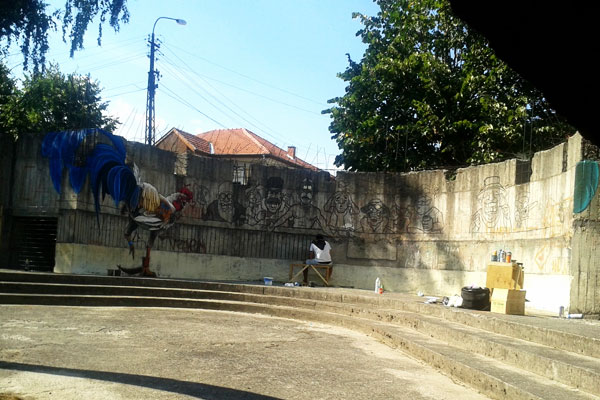
Lapiz Reveals “Rainbow Nation” Mural in Paderborn, Germany

**Lapiz Reveals “Rainbow Nation” Mural in Paderborn, Germany: A Tribute to Diversity and Togetherness**
In the picturesque, historic city of Paderborn, Germany, where medieval structures blend seamlessly with modern urban vibes, a strikingly colorful artwork has come to life. Named “Rainbow Nation,” this mural is the latest creation by Lapiz, the globally acclaimed street artist known for crafting impactful, politically charged, and visually captivating public pieces. Unveiling this mural signifies an important cultural addition to Paderborn’s downtown, interweaving the principles of diversity, togetherness, and social cohesion.
**The Visionary Behind the Mural: Lapiz**
Lapiz has consistently garnered acclaim as one of our era’s most thought-provoking street artists. Hailing from New Zealand, he has roamed the planet producing works that challenge societal conventions and delve into intricate issues such as environmental stewardship, migration, inequality, and justice. Frequently maintaining anonymity, Lapiz skillfully employs stencils and spray paint to create expansive murals with intricate details that resonate with urgent global dialogues. His artistry spans continents—from South Africa to Chile—and now, a remarkable new creation adorns the walls of Paderborn.
**The Essence of “Rainbow Nation”**
“Rainbow Nation” draws inspiration from the phrase popularized by Archbishop Desmond Tutu and later embraced by South African President Nelson Mandela to illustrate the post-apartheid vision of racial harmony in South Africa. Nevertheless, Lapiz’s interpretation of “Rainbow Nation” expands beyond a specific geographical or historical framework, striving to represent the worldwide acceptance of multiculturalism, solidarity, and integration.
The mural visually embodies a vibrant spectrum of colors, depicting individuals from diverse ethnic backgrounds and cultural heritages, all linked by colorful threads and designs that gracefully continue throughout the canvas. Covering a broad section of wall, the mural integrates geometric shapes, silhouettes, and natural elements—trees, birds, and flowing water—that enhance the notion of humanity’s deep connection to the environment and to one another.
The core of “Rainbow Nation” lies not only in its striking colors but also in its depiction of unity amidst division. Each figure in the mural presents varying skin tones and expressions, reaching out their hands to each other in a gesture of connection and solidarity. The background presents a harmonious blend of vibrant hues—predominantly reds, greens, blues, and yellows—highlighting the beauty in diversity.
**The Meaning Behind the Artwork**
Over the years, Paderborn has evolved into a more diverse community, welcoming individuals from various corners of the globe to Germany. In this context, Lapiz’s mural gains further significance, delivering a powerful message to both locals and newcomers. By honoring the beauty of nationalities, ethnicities, and cultures, the “Rainbow Nation” mural stands as a symbol of inclusivity, advocating for unity amid diversity—a message that surpasses urban boundaries.
The figures depicted in the artwork appear anchored yet dynamic—families, children, and elders—all set against a backdrop of vibrant swirls and circular motifs. Birds, a recurring symbol in Lapiz’s art reflecting freedom of movement, are prominently depicted soaring above the pedestrians below. These avian representations convey the profound idea that human beings, much like birds, should not be restricted by artificial borders and that there ought to be freedom to coexist and rise above cultural divisions.
Moreover, the lush elements of nature suggest not only the environmental consciousness central to many of Lapiz’s earlier works but also the vital interconnectedness that encompasses all life on Earth. The flowing river depicted in the lower section of the mural symbolizes the ceaseless flow of life, linking all beings, irrespective of their origins or backgrounds.
**Community Involvement and Collaboration**
The realization of “Rainbow Nation” was not an individual effort. True to the mural’s ethos, Lapiz worked alongside local artists, students, and volunteers from Paderborn’s vibrant artistic community. Various community workshops took place during the project’s earlier phases, inviting individuals of all ages and backgrounds to share their ideas and participate in the creative journey, emphasizing that public art should—and can—engage communities effectively.
“When art is created in collaboration with the community, it transcends mere visual aesthetics. It becomes a reflection of shared narratives and aspirations,” stated Lapiz during the unveiling event. “I aspired for this mural to embody the hopes of a united Paderborn—a city that cherishes diversity and holds onto hope amidst our shared challenges.”
Local citizens were not merely spectators of the creation process; they were integral contributors, adding intricate details and leaving their unique fingerprints within the mural—an impactful expression of ownership and connection to the piece.
**Community Response and Future Aspirations**
Residents of Paderborn, along with visitors, have responded with excitement and fascination to Lapiz’s “Rainbow Nation.” The mural has swiftly transformed into a social